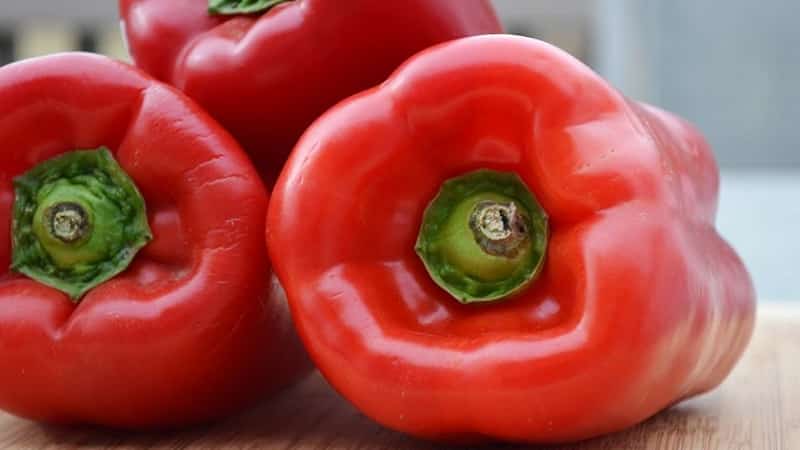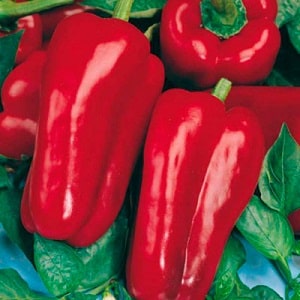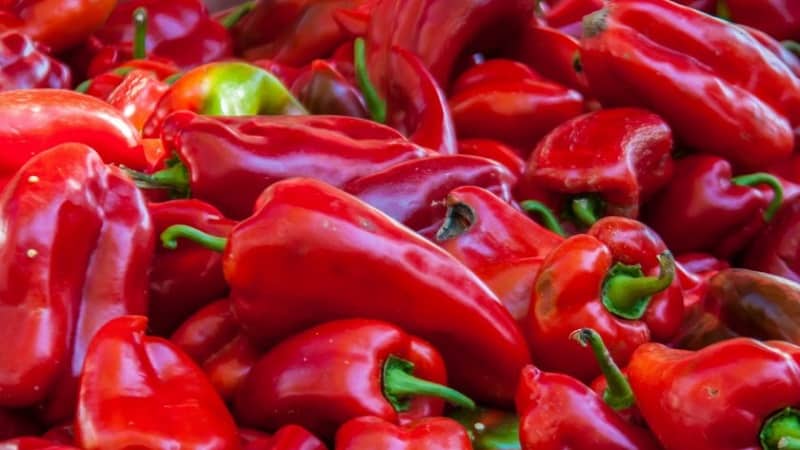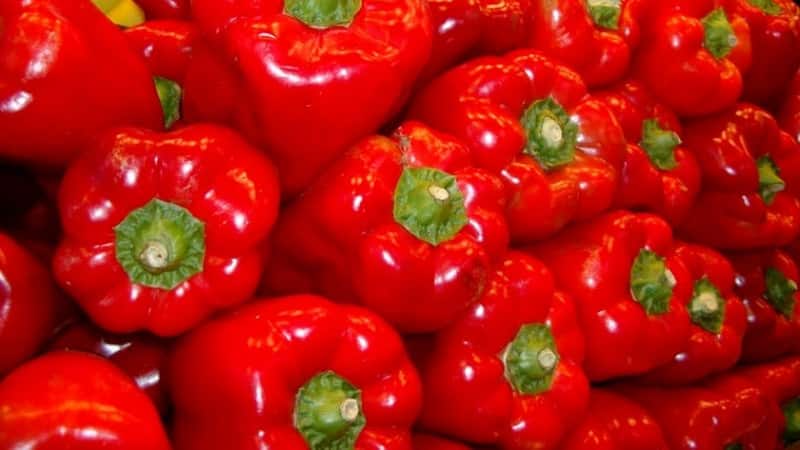How to grow hybrid pepper “Denis” to get a rich harvest of sweet and juicy fruits
Pepper should be included in the diet of everyone who cares about their health - the elements that make up the vegetable are indispensable for the body. The benefits of pepper will increase if you grow it yourself without the use of growth stimulants and chemicals. In order for the invested work to be justified by obtaining a high-quality and tasty product, it is necessary to follow the growing technology.
From the article you will learn how to properly grow hybrid pepper Denis f1 in order to reap a rich harvest, and what are the features of the agricultural technology of this crop.
General characteristics and description of hybrid pepper Denis f1
Hybrid Denis f1 - salvation for gardeners living in regions with a short summer period. Denis belongs to the early-ripening hybrids and is able to please with tasty fruits in conditions under which most peppers do not have time to ripen.

Distinctive features
The hybrid is grown in greenhouses (glass and film), temporary shelters or in open ground. Denis is a low-growing crop: the height of the bush is 60-70 cm. The period from seedling germination to ripeness takes 80-90 days.
Productivity
With the right growing technology the crop gives a rich harvest - 26 kg per 1 m². The bush, grown in greenhouses or shelters, reaches 1 m in height and has 6-7 fruits.
Other varieties and hybrids of peppers:
Description of pepper “Gift of Moldova”
Fruit characteristics
The fruits of the hybrid Denis f1 are large, rich red in color, have an oblong shape, juicy and sweet flesh, are not bitter, and have a rich aroma. Some peppers grow weighing up to 400 g. The vegetable easily tolerates transportation over long distances.
Preparation for cultivation
To grow Denis f1, it is necessary to purchase new seeds annually, since hybrids do not pass on their characteristics to subsequent generations.
Planting material must be the same size, free from rot and plaque, and have a shelf life reserve. Before planting, seeds are sorted and poor quality ones are thrown away.
It is advisable to test seeds for germination:
- Select 10 pieces, put them in fabric bags in warm water for 24 hours.
- Remove and place on a flat surface in a warm place (temperature no lower than 30 °C).
- Keep the bags moist for another 3-4 days. If during this period 5 out of 10 seeds hatch, then good germination awaits you.
Before planting, the seeds are disinfected using a solution of potassium permanganate, and they are also hardened by successive exposure to low and high temperatures for 7 days.
Another factor determining yield, is the quality of the soil used. There are several ways to obtain the correct soil composition:
- mix peat, humus and sawdust in a ratio of 2:2:1 (it is permissible not to use sawdust);
- mix humus with turf (3:2);
- mix manure humus with turf soil (2:1);
- Buy ready-made soil for pepper in the store.
Read also:
Growing seedlings
Denis f1 is planted for seedlings at the end of February — early March in accordance with the rules:
 Lay the soil in a 10 cm layer in the boxes and water it with a solution of potassium permanganate.
Lay the soil in a 10 cm layer in the boxes and water it with a solution of potassium permanganate.- After 12 hours, the soil is leveled and compacted.
- Longitudinal furrows are made in increments of 5 cm.
- Seeds are lowered into furrows at a distance of 2 cm from each other, planting depth is 1-1.5 cm.
- Cover the planting with a thin layer of soil.
- Water with warm water.
Subsequently, the seedlings are watered once a week.using warm, settled water. Picking is carried out in the phase of 1-2 standing leaves, while the sprouts are transplanted into separate containers with a volume of 0.5 liters.
The optimal air temperature for seedlings is considered to be in the range of 16-18 °C.
Important. During the first week, it is better not to expose the seedlings to the sun, as this causes them to stretch out and prevent the root system from strengthening.
It is advisable to fertilize the seedlings with complex fertilizers containing microelements and calcium.
Pepper seedlings love warmth, peace and light, even a super-careful pick injures her. For this reason, it is better to grow seedlings without picking. To do this, plant 2 seeds in a separate container. When sprouts appear, they determine which one is stronger and leave it, pinching off the weak one.
Seedlings are planted in the greenhouse in early or mid-May depending on weather conditions, and in open ground - in early June. By the time of planting, the sprouts should have 8-12 leaves. 2 days before transplanting, the seedlings must be watered abundantly to avoid the earthen clod falling over. You should not water immediately before planting.
Reference. A plant that grew without picking grows stronger: it is ready to be transplanted into the ground a week earlier than indicated.
Features of cultivation and possible difficulties
Pepper is a crop that is demanding on environmental conditions.. For high yields, it needs soil on which nightshade crops have not been planted for at least 5 years.When planting, the distance between rows is 60 cm, and between plants - 50 cm. Pepper grows better in places with diffused light.
 Water the plants regularly; in hot and dry weather, increase the amount and volume of wateringso that the leaves do not dry out. For irrigation, warm water is used, which is pre-settled. Water the vegetable after sunset. After moistening, it is useful to loosen the soil to ensure the supply of oxygen to the root soil.
Water the plants regularly; in hot and dry weather, increase the amount and volume of wateringso that the leaves do not dry out. For irrigation, warm water is used, which is pre-settled. Water the vegetable after sunset. After moistening, it is useful to loosen the soil to ensure the supply of oxygen to the root soil.
During the process of growth and fruiting of pepper, fertilizing is required. The pepper is fed for the first time a few weeks after planting: add superphosphate diluted in water in a ratio of 2:10 to the roots. About 1 liter of fertilizer is consumed for 1 pepper bush.
The second time they feed during the flowering period: superphosphate is diluted in a ratio of 4:10 and 1 tsp is added. potassium sulfate.
The third feeding is done during the ripening period: add 2 tsp per 10 liters of water. superphosphate and potassium salt.
Important. Sweet peppers have fragile shoots that are easy to break. When planting, pegs 60 cm high are placed next to the seedlings to tie up the bushes when they get stronger and begin to rise.
Typical diseases and pests
Pepper Denis F1 is resistant to most diseases, in particular, to tobacco mosaic.
Common diseases include fusarium and verticillium. With these diseases, the bush looks as if it lacks moisture. To prevent these diseases, Previkur is poured directly into the holes when planting. If the disease has already developed, the drug Trichodermin, which is used to treat the roots, is suitable for treatment.
Main pests of pepper - aphids, flea beetles and Colorado potato beetles. The preparations “Tabu”, “Fufanon”, “Intavir”, “Commander”, “Aktara” are suitable for treatment against them.Folk remedies are also suitable for processing. An infusion of ash or tobacco with the addition of laundry soap will remove aphids and will not damage the crop.

Advantages and disadvantages
Basic advantages of the Denis f1 hybrid:
- early ripeness;
- disease resistance;
- high yield rates;
- juicy, tasty fruits;
- Possibility of growing indoors and outdoors.
Main disadvantages — annual costs for planting material, the need for staking and bush formation.
Reviews
Summer residents love hybrid crops, but they are not always able to purchase really high-quality seed material.
Maria, Chaplygin: “I am a beginner amateur gardener. Last spring I tried growing peppers for the first time. My choice fell on Denis f1, since the seed store described it in the best way. I planted the seedlings in a greenhouse. The pepper did not disappoint me, it showed high germination and gave a good harvest, the fruits were large, as in the photo, and juicy. I will definitely buy these seeds next year.".

Alexey, Samara: “I’ve been growing this pepper for several years. The bush grows 0.8-1 m, the leaves are large, 6-7 fruits ripen on the plant, the color is red. I only grow it in a greenhouse. You can get fruits weighing 400 g, but for the normal formation of such peppers you will have to leave 3-4 pieces on the bush. I got Denis with a maximum of 320 g. I recommend the variety.”.
Tatiana, Orlov: “I purchased Denis f1 pepper seeds, and they turned out to be fake. I did everything according to technology, but the seedlings did not sprout. Carefully examine the seeds before planting so as not to waste your time.".
Conclusion
The fruits of Denis f1 pepper are juicy, elastic, and tasty.The vegetable combines many useful properties: early ripening, large fruits, rich harvest, excellent taste. To grow large fruits weighing 400 g, leave no more than 3-4 peppers on the plant.
The harvest will not disappoint if you carefully select seeds and soil and properly care for the plants. The end result is that the consumer receives a universal product for fresh consumption and preservation.